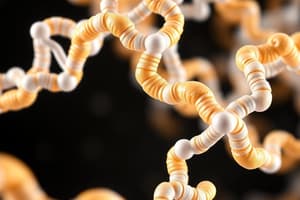Podcast
Questions and Answers
What determines the primary structure of a protein?
What determines the primary structure of a protein?
- Ionic interactions
- Covalent bonds (correct)
- H-bonds
- Van der Waals interactions
What is the significance of the isoelectric point of a protein?
What is the significance of the isoelectric point of a protein?
- It indicates the overall 3-dimensional shape of the protein.
- It determines whether the protein will be globular or fibrous in shape.
- It represents the pH where the protein has a net negative charge.
- It denotes the pH at which the protein carries no net charge. (correct)
Which interaction type determines the tertiary structure of a protein?
Which interaction type determines the tertiary structure of a protein?
- Van der Waals interactions
- H-bonds
- Hydrophobic interactions (correct)
- Ionic interactions
What distinguishes a prosthetic group in a protein?
What distinguishes a prosthetic group in a protein?
What is the term for a short polymer of amino acids?
What is the term for a short polymer of amino acids?
In a protein chain, what are the two ends called?
In a protein chain, what are the two ends called?
What kind of protein has more than one polypeptide chain?
What kind of protein has more than one polypeptide chain?
What are the general functions of proteins?
What are the general functions of proteins?
How are amino acids classified based on their side chains?
How are amino acids classified based on their side chains?
What type of amino acids do not gain or lose protons or participate in hydrogen or ionic bonds?
What type of amino acids do not gain or lose protons or participate in hydrogen or ionic bonds?
Which aspect dictates the role of an amino acid in proteins?
Which aspect dictates the role of an amino acid in proteins?
Flashcards are hidden until you start studying
Study Notes
Primary Structure of Proteins
- The primary structure is determined by the sequence of amino acids in a polypeptide chain.
- Genetic information encoded in DNA translates into specific amino acid sequences.
Isoelectric Point of Proteins
- The isoelectric point (pI) is the pH at which a protein carries no net electric charge.
- This point is significant for protein solubility and stability, affecting purification and separation techniques.
Tertiary Structure Determinants
- The tertiary structure of a protein is primarily determined by various interaction types including hydrophobic interactions, hydrogen bonds, ionic bonds, and disulfide bridges.
- These interactions contribute to the protein’s three-dimensional shape, essential for its functionality.
Prosthetic Groups
- A prosthetic group is a non-polypeptide unit tightly and permanently attached to a protein.
- They assist in the protein’s function, often playing a role in enzymatic activity or binding to other molecules.
Short Polymer of Amino Acids
- A short polymer of amino acids is referred to as a peptide.
- Peptides can vary in length and may exhibit biological activity.
Ends of a Protein Chain
- The two ends of a protein chain are called the amino (N-terminal) end and the carboxyl (C-terminal) end.
- These terminals indicate the directionality of the polypeptide chain.
Multimeric Proteins
- Proteins consisting of more than one polypeptide chain are termed multimeric proteins.
- They can have similar or distinct polypeptide chains, contributing to functional diversity.
General Functions of Proteins
- Proteins perform various functions such as catalyzing biochemical reactions (enzymes), providing structural support, transporting molecules, and regulating biological processes.
- They also play roles in cell signaling and immune responses.
Classification of Amino Acids
- Amino acids are classified based on their side chains: nonpolar, polar, charged, and aromatic.
- This classification influences their behavior in aqueous environments and their role in protein structure and function.
Proton Stability of Amino Acids
- Neutral amino acids do not gain or lose protons or participate in hydrogen or ionic bonds due to stable side chains.
- They are hydrophobic and often found in the interior of proteins, avoiding water.
Role Determination of Amino Acids
- The specific role of an amino acid in proteins is dictated by its unique side chain (R group), affecting interactions and structural shape.
- These properties determine how amino acids contribute to the overall function of the protein.
Studying That Suits You
Use AI to generate personalized quizzes and flashcards to suit your learning preferences.





